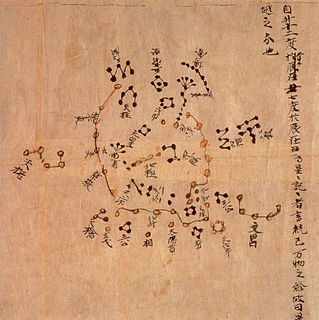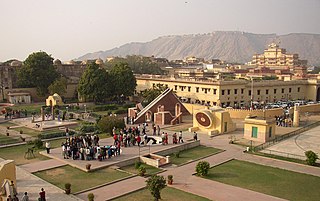
The ecliptic is the plane of Earth's orbit around the Sun. From the perspective of an observer on Earth, the Sun's movement around the celestial sphere over the course of a year traces out a path along the ecliptic against the background of stars. The ecliptic is an important reference plane and is the basis of the ecliptic coordinate system.

The following outline is provided as an overview of and topical guide to space science:

The United States Naval Observatory (USNO) is one of the oldest scientific agencies in the United States, with a primary mission to produce positioning, navigation and timing for the United States Navy and the United States Department of Defense.

In astronomy and navigation, the celestial sphere is an abstract sphere that has an arbitrarily large radius and is concentric to Earth. All objects in the sky can be conceived as being projected upon the inner surface of the celestial sphere, which may be centered on Earth or the observer. If centered on the observer, half of the sphere would resemble a hemispherical screen over the observing location.

An observatory is a location used for observing terrestrial, marine, or celestial events. Astronomy, climatology/meteorology, geophysical, oceanography and volcanology are examples of disciplines for which observatories have been constructed. Historically, observatories were as simple as containing an astronomical sextant or Stonehenge.
Astrophysics is a science that employs the methods and principles of physics in the study of astronomical objects and phenomena. Among the subjects studied are the Sun, other stars, galaxies, extrasolar planets, the interstellar medium and the cosmic microwave background. Emissions from these objects are examined across all parts of the electromagnetic spectrum, and the properties examined include luminosity, density, temperature, and chemical composition. Because astrophysics is a very broad subject, astrophysicists apply concepts and methods from many disciplines of physics, including classical mechanics, electromagnetism, statistical mechanics, thermodynamics, quantum mechanics, relativity, nuclear and particle physics, and atomic and molecular physics.

A celestial event is an astronomical phenomenon of interest that involves one or more celestial objects. Some examples of celestial events are the cyclical phases of the Moon, solar and lunar eclipses, transits and occultations, planetary oppositions and conjunctions, meteor showers, and comet flybys, solstices and equinoxes.
Paul G. Comba was an Italian-American computer scientist, an amateur astronomer and a prolific discoverer of minor planets.

The Vatican Observatory is an astronomical research and educational institution supported by the Holy See. Originally based in the Roman College of Rome, the Observatory is now headquartered in Castel Gandolfo, Italy and operates a telescope at the Mount Graham International Observatory in the United States.

Astronomy in China has a long history stretching from the Shang Dynasty, being refined over a period of more than 3,000 years. The Ancient Chinese people have identified stars from 1300BCE, as Chinese star names later categorized in the twenty-eight mansions have been found on oracle bones unearthed at Anyang, dating back to the mid-Shang Dynasty. The core of the "mansion" (xiù:宿) system also took shape around this period, by the time of King Wu Ding.

Leo (♌︎), Latin for Lion, is the fifth sign of the zodiac. It corresponds to the constellation Leo and comes after Cancer and before Virgo. The traditional Western zodiac associates Leo with the period between July 23 and August 22, and the sign spans the 120th to 150th degree of celestial longitude.

The Jantar Mantar is a collection of 19 astronomical instruments built by the Rajput king Sawai Jai Singh II, the founder of Jaipur, Rajasthan. The monument was completed in 1734. It features the world's largest stone sundial, and is a UNESCO World Heritage site. It is located near City Palace and Hawa Mahal. The instruments allow the observation of astronomical positions with the naked eye. The observatory is an example of the Ptolemaic positional astronomy which was shared by many civilizations.

Jantar Mantar is located in the modern city of New Delhi. “Jantar Mantar” literally means “instruments for measuring the harmony of the heavens”. It consists of 13 architectural astronomy instruments. The site is one of five built by Maharaja Jai Singh II of Jaipur, from 1723 onwards, revising the calendar and astronomical tables. Jai Singh, born in 1688 into a royal Rajput family that ruled the regional kingdom, was born into an era of education that maintained a keen interest in astronomy. There is a plaque fixed on one of the structures in the Jantar Mantar observatory in New Delhi that was placed there in 1910 mistakenly dating the construction of the complex to the year 1710. Later research, though, suggests 1724 as the actual year of construction. Its height is 723 feet (220 m).

Judson B. Coit Observatory is an astronomical observatory owned and operated by Boston University on the roof of the College of Arts & Sciences at 725 Commonwealth Avenue in Boston, Massachusetts, USA. The observatory is used in undergraduate and graduate courses of the Boston University Department of Astronomy, and for observing projects of the Boston University Astronomical Society.

Cordell–Lorenz Observatory (850) is an astronomical observatory owned and operated by Sewanee:The University of the South. It is located in Sewanee, Tennessee, United States.

Capricorn(♑︎) is the tenth astrological sign in the zodiac out of twelve total zodiac signs, originating from the constellation of Capricornus, the horned goat. It spans the 270–300th degree of the zodiac, corresponding to celestial longitude. Under the tropical zodiac, the sun transits this area from about December 21 to January 21 the following year, and under the sidereal zodiac, the sun transits the constellation of Capricorn from approximately January 16 to February 16. In astrology, Capricorn is considered an earth sign, negative sign, and one of the four cardinal signs. Capricorn is said to be ruled by the planet Saturn.

An infrared telescope is a telescope that uses infrared light to detect celestial bodies. Infrared light is one of several types of radiation present in the electromagnetic spectrum.
In astronomy, an equinox is either of two places on the celestial sphere at which the ecliptic intersects the celestial equator. Although there are two intersections of the ecliptic with the celestial equator, by convention, the equinox associated with the Sun's ascending node is used as the origin of celestial coordinate systems and referred to simply as "the equinox". In contrast to the common usage of spring/vernal and autumnal equinoxes, the celestial coordinate system equinox is a direction in space rather than a moment in time.
The RUM Planetarium is the first planetarium in Puerto Rico. It is located in the fourth floor of the Physics building of the University of Puerto Rico at Mayagüez in Mayagüez, Puerto Rico.














